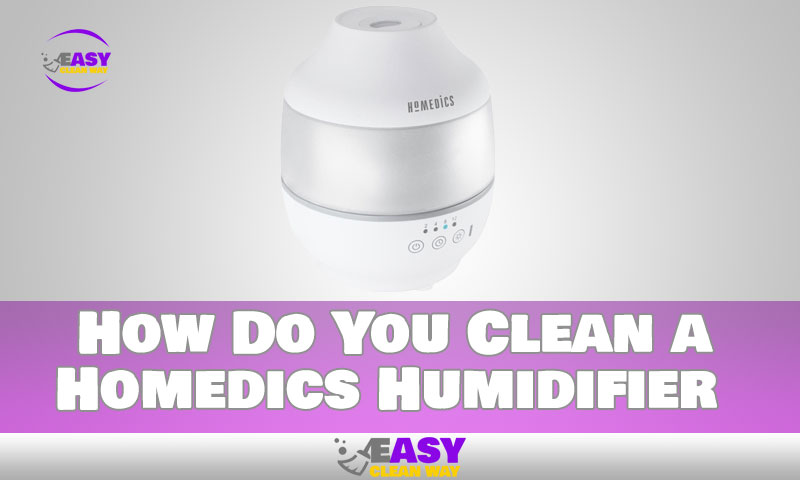If you own a Homedics humidifier, you know that proper maintenance is key to its longevity and performance. Humidifiers require regular cleaning to ensure they are functioning optimally and to prevent the buildup of mold and mildew.
Cleaning a Homedics humidifier is easy but can be time-consuming, so it’s important to do it right. This guide explains how to clean your Homedics humidifier step-by-step, so you get the most out of your appliance.
We’ll cover everything from cleaning the tank and base, to descaling and disinfecting it. We’ll also share some tips for keeping your humidifier in top condition for years to come. With just a little bit of work, you can make sure your Homedics humidifier is always cleaning the air in your home efficiently and safely.
Why Is It Important to Clean Your Homedics Humidifier?
Maintaining your humidifier’s functionality and lifetime requires regular cleaning. Your home’s air quality may be impacted by mold and bacteria growth caused by stagnant water in the humidifier. It’s crucial to clean your humidifier on a weekly basis to keep it functioning at its best.
In order to do this, mix white vinegar and distilled water 50/50. This solution will dissolve any calcifications or mineral deposits that may have built up inside the device over time. Prior to reinstalling it for use after cleaning, be sure to give it a thorough rinse with pure, distilled water.
What Supplies Will I Need to Clean My Homedics Humidifier?
The supplies you need to clean a Homedics humidifier vary slightly depending on the model. Regardless of the model, you will need to have a 50/50 mix of white vinegar and water and distilled water on hand. For more intense cleaning, it is also recommended to use bleach or hydrogen peroxide, but these items are optional.
White vinegar and water should be mixed in an equal ratio in a bowl or other container to create your cleaning solution. If you are opting to use bleach or hydrogen peroxide, make sure your container is designed for use with disinfectants. Moreover, confirm that neither your vinegar-water mixture nor your distilled water has any other additives, such as oil or scent. You can prevent accidentally harming your humidifier by carrying out this step appropriately.
Once you have collected all the necessary materials it is easy to move forward with cleaning your Homedics humidifier!
What Are the Steps to Properly Clean a Humidifier?
Cleaning a Homedics humidifier isn’t difficult, but it is important to take the necessary steps to ensure that your device is properly cleaned and sanitized. Here’s what you need to do:
Empty and Rinse the Tanks and Caps
First, unplug your humidifier and empty any water remaining in the tank. Once it’s empty, rinse out the tank and all of its caps with clean water. Make sure to rinse out all of the nooks and crannies, so no residue is left behind.
Create a Solution
Then, mix 50/50 white vinegar and water to make a solution. This solution should be poured into the tank halfway and left to sit for 15 minutes. This will aid in drawing out any accumulated mineral deposits from the tank.
Rinse Out Solution
After 15 minutes has passed, empty out the solution and rinse everything separately with clean water once again. This will help ensure that no vinegar residue is left behind. Make sure to scrub away any mineral deposits before rinsing each item out thoroughly.
How Often Should I Clean My Homedics Humidifier?
To make sure your HoMedics humidifier operates at peak performance, cleaning it is crucial. Cleaning your unit at least once a week will keep it in peak shape and prevent the growth of bacteria and mildew.
It is much more crucial to periodically clean the humidifier if you use it frequently or live in a humid environment. If so, you ought to attempt to clean it every 120 hours of use.
You can keep your HoMedics humidifier working like new for many years by using the advice in this article.
What Is the Best Way to Store My Humidifier When Not in Use?
When it’s not humidifying the air, you should be storing your Homedics humidifier in a cool, dry place. Before doing so, however, make sure to do the following:
- Empty the water tank and refill it daily. This will stop bacteria from growing since there won’t be any old water sitting in the tank.
- Clean the ultrasonic membrane with vinegar or citric acid. This will help to remove any minerals or scale build-up that could cause corrosion or other damage over time.
- Keep the area around the humidifier as dry as you can to prevent mould and other buildup. This will aid in preventing any excess moisture from building up on surfaces, which can encourage the growth of mould and mildew.
Common Questions About Cleaning a Homedics Humidifier
You may have some questions about cleaning your Homedics humidifier. Here are answers to some of the most common inquiries:
Can I use any cleaning products?
No, it’s best to stick to mild, non-abrasive detergents when cleaning your Homedics humidifier. To ensure that no harsh chemicals come in contact with the device, try making a 50/50 mix of white vinegar and distilled water.
Is there anything else I need to know before I get started?
Yes, you should disconnect your Homedics humidifier and remove the water tank, filters, and other removable components before you start cleaning it. To make sure that nothing is harmed in the process, this should be done as a precaution.
People Also Like: How to Clean a Mouse Wheel
Conclusion
In short, keeping your Homedics Humidifier clean is an important part of ensuring optimal performance. From unplugging, to cleaning the tank, to replacing the filter, you can have your humidifier running like new with the simple steps outlined in this guide. This will prolong the life of your equipment in addition to keeping your air pure. You can maintain healthy humidity levels and keep bacteria and allergens out of your home with only a few minutes of focused attention.
Hey there! I’m Alton Smith, your Clean Expert blogger. I’m on a quest to help you conquer chaos and embrace the joys of a tidy life.





